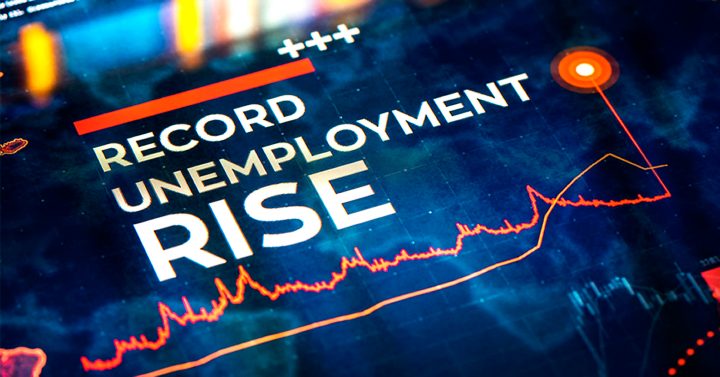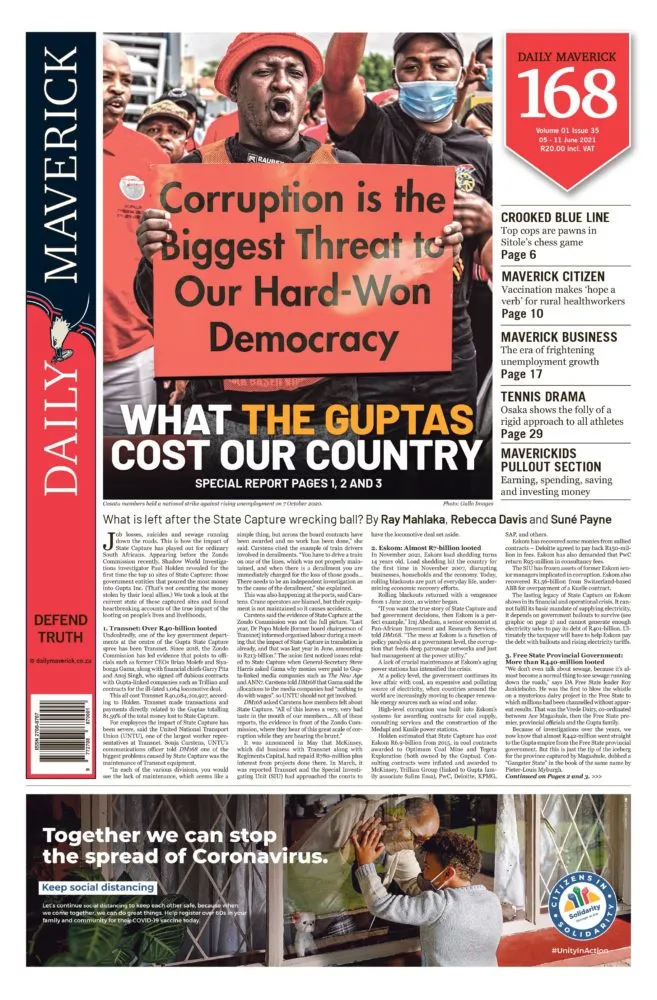BUSINESS MAVERICK 168
Twin shocks of economic contraction and Covid-19 reverberate through SA’s unemployment line

The economy may be improving, but this has not translated into jobs – the recovery would have to be sustained for several quarters before employment figures shift positively.
First published in the Daily Maverick 168 weekly newspaper.
Statistics South Africa will release the GDP data for the first quarter (Q1) of 2021, on 8 June. This release of the economy’s trajectory follows the 7% contraction of 2020 in the face of the once-in-a-century event, which is our current Covid-19 pandemic.
According to the South African Reserve Bank, the contraction was also an event on the same time scale – the biggest decline in economic output in South Africa in a century. So there is scarcely anyone in South Africa alive who has experienced either catastrophe.
The impact of these twin shocks has been nothing short of seismic, especially on the employment front, which is deeply worrying. South Africa’s economy is probably growing again, but this has not been accompanied by meaningful job creation, according to the latest data, which shows unemployment at record highs.
In the early 1990s, American economist Nick Perna coined the phrase “jobless growth”, referring to an economy that grows without creating jobs.
This may not explain South Africa’s current situation – jobs are a “lagging indicator”, so growth would have to be sustained before employment trends reverse in a positive way.
“You need a few quarters or a few months of growth to have a change in the trajectory of jobs,” Mike Schussler of Economists.co.za told DM168.
If growth is at least being maintained from the massive Q2 contraction of over 50% last year, the first confirmation of that will come with the Q1 GDP number on 8 June.
Positively, forecasts have been revised sharply upward from where things stood just a couple of months ago. The Reserve Bank, for example, now estimates that the economy in the first three months of this year grew 2.7% – a significant change from March, when it was predicting a 0.2% contraction. Private-sector economists and analysts have also been revising their forecasts upwards, although the numbers have been all over the show, with some still predicting a contraction, underlining the uncertainty of the current economic environment.
A Reuters consensus view is a year-on-year shrinkage of 4.1% but growth of 6.3% quarter on quarter annualised.
There has been data aplenty pointing to a rebound from last year’s depression-level event, although it has been decidedly mixed.
One of the few bright spots has been surging commodity prices, notably for platinum group metals (PGMs) but also iron ore and others. Partly as a result of this, South Africa’s trade balance was positive in Q1 and this extended into April. Data published on 31 May by the South African Revenue Service showed a trade balance surplus in April of R51.24-billion. This brings the cumulative surplus for the first four months of 2021 to R147.83-billion compared to a deficit of R4.41-billion in the same period last year.
In March, mining production shot up 21.3% year on year, partly because of base effects – in March 2020 there was a 14.9% decline. PGM production soared 69%. Mining accounts for around 8% of GDP, so a bounce like that will feed positively into the overall number.
Other data has not been as upbeat. Retail trade sales declined by 2.5% in March year on year after rising 2.2% in February, in what at the time looked like a green shoot. That has since withered.
“Except for the elevated commodity prices, we still have weak local fundamentals, even weaker now than ever before,” said NKC African Economics economist Pieter du Preez.
Where are the jobs?
The jury is out on the economy’s Q1 performance, but regardless, jobs are not being created. The Quarterly Labour Force Survey (QLFS) for the period showed that the official unemployment rate increased from 32.5% in Q4 of 2020 to 32.6% in Q1 of 2021. This is a record since the QLFS was launched in 2008, according to Statistics South Africa (Stats SA). The rate under the expanded definition, which includes those who have given up on the hunt for a job, is now 43.2%. Youth unemployment under the expanded definition is a staggering 74.7%.
“We note that the momentum in the quarterly job gains in the last two quarters of 2020 slightly reversed in 1Q21. Worryingly, the level of employment was still 8.5% (or about 1.4 million), materially lower in 1Q21 relative to 1Q20, while unemployment was 2.5% (or about 172,000) higher over the corresponding period.
“The population not economically active, neither unemployed nor employed, was up by 11.6% (or about 1.8 million) in 1Q21 relative to 1Q20,” FNB economist Thanda Sithole said in a commentary on the data.
“This reflects sustained slack in the labour market amid the profound and lingering impact of the pandemic. It also corroborates our view that employment gains are likely to be modest over the near to medium-term horizon due to the hysteresis nature (i.e. lagged response) of the labour market around the business cycle following an economic shock,” Sithole said.
In other words, because of the scale of the shock, businesses are simply not in a rush to hire.
And the bloodbath has been across the board – outside of the financial services sector.
“The finance industry created 10,000 jobs in 1Q21 relative to 1Q20 and was the only industry that recorded year-on-year employment gains. Annual job losses were recorded in all other industries,” Sithole noted.
Schussler of Economists.co.za said that the economy needed to grow three times faster than its population growth rate of 1.5% – so 4.5% growth, sustained over a period of time, is needed in his view to make a dent in unemployment.
He also noted that output levels are not back to prepandemic levels.
“Because of this, one should call it recovery rather than growth. And during this recovery, we are recovering some of the jobs, but not all of them yet. We need more certainty for businesses where they will make that employment decision and investment decision again. At the moment there is a lot of uncertainty about rules and regulations.”
Labour-intensive sectors such as tourism are still struggling. And even the mining sector has only a handful of new investments and projects of any significance on the cards, and they are for the most part expansions to existing operations.
So the commodity boom has not yet translated into “export-led job growth” which is often seen as a panacea.
The unemployment situation is clearly an unfolding crisis that has been decades in the making. It means poverty, hunger and inequality are also on the rise, ripping gaping holes in the wider social fabric. It is no coincidence that South Africa also has high levels of social unrest – itself a deterrent to the investment needed to create jobs and wealth.
And for economic growth to make a difference, it will need to be sustained, and this is just not going to happen so long as load shedding and policy uncertainties persist.
And if these things get fixed down the road – a big if – automation and other trends could still herald a period of “jobless growth”.
Some economists will also point to rigid labour laws – if it is difficult to fire, there is a disincentive to hire. Then there is the dearth of skills and a broken education system that is not moulding a literate, productive and competitive 21st century workforce. The list could go on and on. In the meantime, expect the ranks of those begging at dysfunctional traffic lights to swell further. DM168
This story first appeared in our weekly Daily Maverick 168 newspaper which is available for free to Pick n Pay Smart Shoppers at these Pick n Pay stores.

















 Become an Insider
Become an Insider
Comments - Please login in order to comment.